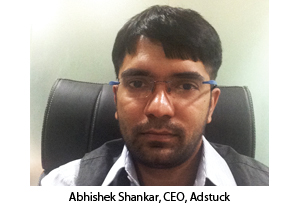Home » Viewpoints » The augmented effect on OOH reality...
The augmented effect on OOH reality...
By M4G Bureau - May 05, 2014
Augmented Reality (AR) could redefine the way brands can use the OOH medium to drive audience engagement and connect. Abhishek Shankar, CEO, Adstuck, shares more on this with Outdoor Asia. Read on...
 With interactive technologies redefining communications, sky's the limit when it comes to conveying a brand message and offering an attention-grabbing experience. Augmented Reality (AR), a way of offering an enhanced experience or perception of reality by means of computer-generated sensory inputs such as sound, video, graphics or GPS data, is one such technology buzzword doing the rounds today. AR has the potential to change the OOH ballgame by providing an engaging and interactive value addition to the medium. Abhishek Shankar, CEO, Adstuck, an Augment Reality software and apps development company which has brought this technology to India and successfully executed campaigns for various brands and category, shares with Outdoor Asia how AR works in the OOH context. Given below are excerpts from the conversation.
With interactive technologies redefining communications, sky's the limit when it comes to conveying a brand message and offering an attention-grabbing experience. Augmented Reality (AR), a way of offering an enhanced experience or perception of reality by means of computer-generated sensory inputs such as sound, video, graphics or GPS data, is one such technology buzzword doing the rounds today. AR has the potential to change the OOH ballgame by providing an engaging and interactive value addition to the medium. Abhishek Shankar, CEO, Adstuck, an Augment Reality software and apps development company which has brought this technology to India and successfully executed campaigns for various brands and category, shares with Outdoor Asia how AR works in the OOH context. Given below are excerpts from the conversation. The birth of Augmented Reality -- Mobile was the Push
Over a period of time, Mobile became a medium and it was pushing the content business overall. People started using more advanced cell phones and discovered SMS communications; user acceptance moved towards data features. The tech community realized that there could be multiple ways of engaging users. Around 2012, Augment Reality started picking up when iphone was just launched and Android was still picking up (it began doing so in 2010-'11) .
Augmented OOH
When it comes to Augmented Reality, a billboard or a mall standee is like a print medium. It started with proximity based marketing. The developers then took the initiative and informed brands, which were already spending very high on these places, that there was a way to value-add on not only in terms of visibility, but also engagement by just pointing a phone to the display. The first among those brands were Dominos. So Blippar came up with proximity based solution which mixed Augment Reality with other factors. We were into the back end of it and we came out with a solution by which the creative also incorported messages which informed about their nearest Dominos Corner and a quick to call feature. It ensured a 10 minute pizza delivery to the users if they were in the proximity. And then there was a food & beverage industry giant who used AR at the outside location. Around 25,000 users scanned the data in seven days in the UK!
AR and the Indian OOH Industry
The problem in India lies with the education. We need to educate the stakeholders who are involved in the business of Augmented Reality. Brands are already educated; they just don't have the mediums to employ it or the access to expertise by which it can be used in the OOH medium.
In the Indian OOH industry, Adstuck has the distinction of launching Augment Reality in the country. In September 2012, we developed an application for Maruti for their Alto 800 model. They had a particular TG in mind which was in the Smartphone category, but which also involved the regular phone users considering it was a Rs 2-2.5 lakh car. They had spent a lot on OOH advertising;, they went in for around 700-800 OOH ads in Delhi alone. We augmented the multiple billboard creative and using that provided 10 features to the users at different intervals of time. The first thing was about letting the user know about how this car was different from Alto and Maruti 800. And then we also communicated the rates and other features, but in a much more advanced way. It was different from their commercials. The fact is that in the OOH medium, no one had thought that you could take out a mobile phone and point to a billboard and it would bring out something creative. We also launched other intiatives like informing about a test drive using the AR feature. Whenever somebody scanned a billboard, they would get a message immediately that a test drive had been booked with the time and place details. We thus made the location based AR possible.
Maruti was anyway going to take the effort and spend money on these billboards, but with the same effort, the effects were amplified 10-15 times because users could now be engaged. A critical thing happened during this campaign, which was that the yield of their banner ads got reduced and the mobile phones impact increased at around 10-15 times.
Initially it was a bit difficult in India to pitch this to new clients, especially the big players, and telling them that their innovation would go in this direction. So, we actually explained the benefits to them and once they saw the results, they got excited. Today our clients are making Augment Reality a part of their mainstream medium and augmenting their creative's across the media.
In a city like Delhi or Noida, most of the hoardings are occupied by the real estate category, so we are working with 10 different real estate giants currently. We provide them the 3D model of their projects. The billboards help them in multiple ways wherein one bilboard actually showcases the whole building by offering a 3D view, the other offers a panoramic inside view of the building and another gives an indication of what stage the building/flat is in. This increases the credibility and accountability of the builder . Another active category is automobiles. We started with Maruti Suzuki and now we are in talks with BMW and Volvo.
It's no rocket science!
There is a perception that such innovations are time-consuming and hard to execute. But the fact is that such technologies work on the basis of image recognition. We don't need to change what has been done in the creative. We just take an image of a billboard creative, put it onto the sytem or upload on the website i.e. studio.aerialmation.com. First, there is a need to create a profile there, then we log in, upload a good creative image there and connect it with the existing website, link or creative or, create a new content on the website itself. You can develop 3D content, HTML file, new videos, or content. To create location based AR, we just need the latitude and longitude of the site. This will inform that this scan has been done at a particular location or billboard. It is as easy as sending an email.
Challenges: Getting Resolved
The main challenge, which though is getting resolved slowly, is about asking a user to point to something with his or her phone and grab their attention. Gradually they will realize that they have actually downloaded an application. As time progresses, it wouldn't take much time as people are becoming more app savvy. Whenever they come to know about any application, there are 70% chances that they will download it in the first interaction. Currently it is easier to click, open a browser and go to a website, but six months down the line, people will be more savvy to go to the app store and downloade the apps, as it gives them the possibility that anything new from that brand will stay with them. Mobile is the future so it makes sense to invest in a strategy which involves mobile and combines other efforts like OOH.
Absolutely Quantifiable
This technology gives a very good picture of all the billboards' performance in terms of engagement because again, mobile phone gives you the possibility of knowing the demography, users profiles etc, which stand-alone billboards can't do. It is the complete feature of digital which comes to the billboard with the usage of Augmented Reality.

Stay on top of OOH media trends
Advertisement







